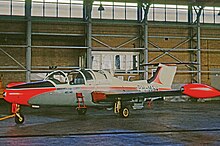Morane-Saulnier MS.760 Paris
Following the failure of the French Air Force to select the Fleuret, Morane-Saulnier opted to develop the design into a liaison aircraft and compact business jet.The Paris retained the flight characteristics of the Fleuret along with the option for installing armaments, which maintained its potential for use as a military trainer as well for civil aviation.During the early 1950s, the French Air Force sought a jet trainer suitable to the ab-initio training sector; in response, Morane-Saulnier produced their own submission, designated as the MS.755 Fleuret.[4] According to M. Vichou, the head of the design department of Morane-Saulnier, the decision to adopt a pair of Turbomeca Marboré jet engines had been determined to be the superior option available; studies found that a single turboprop engine capable of providing at least 2,000 hp was necessary to produce a comparable performance, which would have resulted in the additional complications of appropriately accommodating a fairly large propeller in the design.At the same time, roughly 200 aircraft were reportedly on order; while the French Air Force was still the primary customer for the type, additional export sales arrangements had been achieved with ten separate foreign countries.[6] As early as 1955, even prior to the Paris having entered into production, it was known that American manufacturer Beech Aircraft held considerable interest in the programme, and was reportedly considered options for producing the type in North America under licence from Morane-Saulnier.[5] In response to this interest, senior design staff at the French company spent considerable time in the United States during the development phase of the programme.[5] Detailed production plans were mooted by Beechcraft and Morane-Saulnier; one key difference of the projected American-built aircraft was the adoption of the US-built Teledyne CAE J69 engine, a licence-built development of the Marboré, to take the place of the French-built powerplants.[5] Beechcraft led approaches to both the United States Navy and the Royal Canadian Air Force, offering the Paris to meet their requirements for a jet-propelled trainer aircraft.[8] During 1961, production commenced on an improved variant of the type, designated as the MS.760B Paris II, fitted with a pair of Marboré VI 480 kg engines, wingtip fuel tanks, air conditioning, and an enlarged luggage compartment.[10] From 1958 to the early 1970s, a single MS 760 was used as a flying classroom at the "College of Aeronautics" at Cranfield, United Kingdom; the aircraft was equipped to study stability and control together with performance as part of the MSc course.[13] The company reportedly had ambitions to refurbish existing airframes and to install current-generation jet engines and avionics for the purpose of selling them on to operators for approximately $550,000.



La Ferté-AlaisTrainer aircraftManufacturerMorane-SaulnierFrench NavyFrench Air ForceArgentine Air ForceMorane-Saulnier MS.755 Fleuretjet trainerMS.755 Fleuretbusiness jetside-by-side seatingmaiden flightBeech AircraftGrumman EA-6B Prowlerab-initioFouga MagisterFlight Internationalejectionjet propulsionturboproppiston engineTurbomeca Marborépropellerdive-brakeundercarriagemotorsalternatorsbatteriesmouldingpressurizedair-conditionedT-shaped vertical stabilizerTurbomeca Marboré IIturbojetsNord NoralphaNord Norécrinlicenseunder licenceCanadaTeledyne CAE J69United States NavyRoyal Canadian Air Forcebusiness jetsLockheed JetStarNorth American Sabrelinerair conditioningbankruptcyArgentinian Air ForceBrazilian Air ForceDugny-Le BourgetFabrica Militar de AvionesGroningen AirportCranfieldUnited KingdomHyèresDassault Super ÉtendardVought F-8 Crusaderinstrument flight rules1963 Argentine Navy Revoltradio stationtype certificateSOCATAMendoza, ArgentinaArgentinaBrazilFranceFrench ArmyAspect ratioTurboméca MarboréAircraft Owners and Pilots AssociationWayback MachineAir EnthusiastTaylor, John W. R.AN/ANB/ANR/ANL/ANSMoS.10MoS.11MoS.12MoS.13MoS.14MoS.15MoS.16MoS.17MoS.18MoS.19MoS.20MoS.21MoS.22MoS.23MoS.25MoS.26MoS.27MoS.28MoS.29MoS.30MoS.31MoS.32MoS.33MoS.34MoS.35MoS.42MoS.43MoS.50MoS.51MoS.52MoS.53MoS.56MoS.60MoS.120MoS.121MoS.129MoS.130MoS.131MoS.132MoS.133MoS.134MoS.136MoS.137MoS.138MoS.139MoS.140MoS.141MoS.147MoS.148MoS.149MS.152